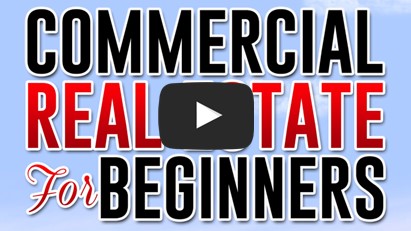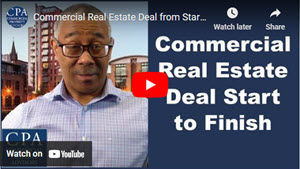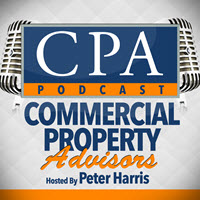
People complain that commercial property is overpriced and all the great deals are taken. They refuse to invest in commercial real estate because they don’t believe there is significant cash-flow. However, the truth is that the very best commercial deals are created, not found. In this post you will learn new ways to look at deals that will get you creating rather than competing. You’ll also discover how to turn a bad commercial deal into a good one and how to tell if a bad deal is worth purchasing.
Diamonds in Your Own Back Yard
There once was an African farmer who heard that others were making millions in diamond mines. He wanted to make millions too, so he decided to sell his farm and find his own diamond mine. After spending years wandering the deserts of Africa looking for his treasure and finding nothing, he became so broken and discouraged that he threw himself into a river and drowned.
Meanwhile, the man who purchased the farmer’s farm was walking around one day and noticed an unusual stone in a stream on the property. Upon further investigation, he learned the rock was a diamond and discovered that the entire farm was covered in acres and acres of diamonds.
Had the first farmer educated himself to understand what diamonds look like in their rough state, he would have realized that he was already sitting on his treasure. There was no need for him to go out searching for diamonds because they were in his own backyard.
This story illustrates 3 key points:
- Diamonds don’t look like diamonds in their rough state and neither do good commercial real estate deals.
- You could have acres of diamonds in your own backyard and not even know it.
- You must learn how to spot commercial real estate diamonds.
How to Turn a Bad Deal into a Good Deal
In order to identify a commercial real estate diamond, you need to unpeel the layers until you find something good about the deal. To see if you can turn a bad deal into a good deal, you need to ask yourself three questions.
- Is the deal priced under or over market?
- Can I raise the rents?
- Can I use creative financing?
Example Bad Deal # 1
- A 12-year-old apartment building with an asking price of $900,000. Market value is $850,000 according to the sales comp. The deal is overpriced by $50,000.
- The property needs $25,000 in repairs. There’s peeling paint on the exterior, terrible landscaping and pending city fines for the poor condition of the property.
- There are 12 units in the apartment, all priced under market by $150 a month due to the condition of the property.
Most people will pass this deal right by because on the surface it’s not a good deal. However, before passing on any deal you must answer the 3 questions.
- The property is priced over market, this is a bad thing.
- The rents can be raised by $150, which is a good thing.
- We don’t know if we can deploy creative financing. We haven’t found out what the seller’s motivations are.
The Impact of Raising the Rents:
With a $150 rent upside for each of the 12 units there is a potential annual rent increase of $21,600. This is extremely important because, as the NOI goes up, the property value goes up. The NOI has a huge impact on the value of a commercial property. An increase in NOI of $21,600 divided by the market cap rate, ($21,600 divided by 7%), equals $308,000. By increasing the NOI by $21,600, the property is now worth $308,000 more. This is what we call forcing the equity on a commercial property. You can’t do this on your residential property, only on a commercial property.
(I used a 7% cap rate because this is the market cap rate in my area. To find out the market cap rate in your area, you can call several local brokers and ask them what the going cap rate is for a C class 12-unit apartment building. To come up with a reasonable estimated cap rate, average their answers.)
Can This Example Be Turned into a Good Deal?
Even though the property is priced $50,000 over market value at $900,000, the potential increased property value of $300,000 turns this bad deal into a good deal. The $25,000 in repairs will scare away most buyers but in order to take advantage of the upsides of the deal, the repairs are necessary.
Example Bad Deal #2
- 3000 Square foot office building that is listed at $900,000, which market comps show us is $50,000 above market value.
- There is no possibility of a rent increase, which means the income that the property is capable of producing is currently maxed out.
- The owner has also expressed some concerns about paying capital gains taxes.
Before passing on any deal we must answer the 3 questions:
- This property is priced over market. This is not a good thing.
- The rents can’t be raised, which is also not a good thing.
- We may be able to use creative financing due to the seller’s concern about the property gains taxes. Remember, to do anything creative in all real estate, you need to find out the seller motivations and then restructure the deal around the that.
Can This Example Be Turned into a Good Deal?
Creative deals are structured around seller motivation, which is exactly what you have with this deal. In this case I would use a master lease agreement with the following terms; a 10% down payment and pay 5% interest payments to the owner for five years. This would mean that with a Master Lease Agreement the seller would only have to pay taxes on the 10% down payment.
Conventional vs Creative Financing
Bank financing would require 15% down, plus interest, and would require a much larger mortgage payment every year. This would make your cash on cash return 5%. However, with creative financing and the master lease agreement, your lower down payment and five-year max interest payments would decrease your mortgage and expenses, increasing your cash on cash return to 15%.
The Importance of the 3 Questions
Question #1: Is the Deal Price Under or Over Market?
I believe that if you want to be a good steward of your money, you need to know if what you are buying is a good deal or not. You need to know where the deal stands in the market. A bad deal is if you’re overpaying with nothing in the future to compensate for the overpaying.
I recommend you watch my video called The Secret To Commercial Real Estate Success. You’ll discover more in depth what to look for, how not to overpay on your deal, and the terminology you need to know to ensure you are a responsible investor.
Question #2: Can I Raise the Rents?
Investors all around the country want to raise the rents because we know if we raise the rents and raise the NOI, our property value goes up. By inching up the rents over the years, we force the value to create massive wealth. No matter the size of the company, they all do the exact same thing. Raising the NOI by raising the rents gives you options so that you can increase your cash flow. One option is to sell the property and buy a bigger one since it’s worth more now. Another option is to cash out refinance, which is one of our favorite techniques.
Cash Out Refinance
This is just like doing a cash out refinance on a home, whereby you get a higher value and a lender gives you money at closing that’s tax-free. All investors use this powerful tool to refinance at some point. We pull out cash to either pay ourselves back, pay investors back or do improvements to the property. I share how to do that in detail in a video called the Secret to Refinancing. By raising the rents, the property creates wealth.
Question #3: Can I Employ Creative Financing?
One of my favorite techniques is the master lease agreement. We’ve done a ton of successful deals across the country this way. This method works well so long as your paperwork is tight. I have a video called Buying Commercial Real Estate Without Bank Loans you can watch to learn more. This is so important if you want to learn how to turn bad deals into good ones.
Once you have a good understanding of how to turn bad deals into good deals, you’ll be able to find diamonds in your own backyard without selling the farm.



